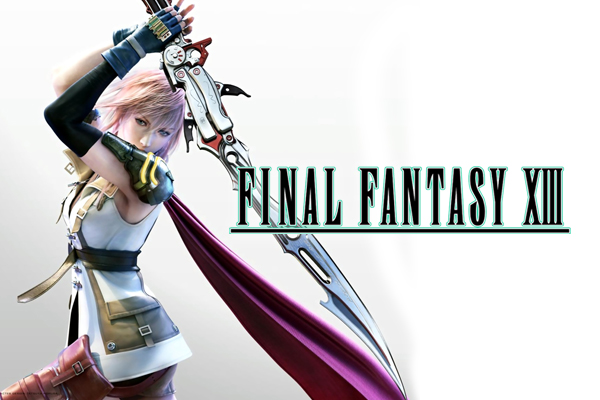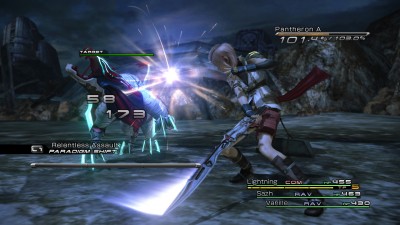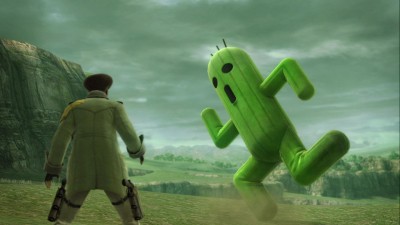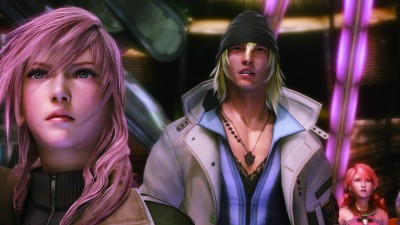
 It’s been almost four years since the last Final Fantasy. A new generation of gaming, a long development cycle, and a controversial multi-platform announcement have all led us to the release of Final Fantasy XIII.
It’s been almost four years since the last Final Fantasy. A new generation of gaming, a long development cycle, and a controversial multi-platform announcement have all led us to the release of Final Fantasy XIII.
The first in a trilogy of XIII related games entitled Fabula Nova Crystallis (with the other two parts being Versus for the PlayStation 3 and Agito for the PSP), Final Fantasy XIII is a new breed of Final Fantasy. Story-wise, all the staples are there. Each of the six protagonists was built on previous characters in the series, and while there’s a noticeable amount of corny melodrama in the script, that’s come to be expected from the franchise and many will find it endearing.
Set in the floating civilization of Cocoon and the looming world below known as Pulse, the game follows the exploits of six characters from different walks of life and their struggle against the corrupt government, powerful super-beings, and fate. Most will recognize Lightning, the strawberry-haired heroine who adorns the box art, and she is accompanied by a motley crew of five others, all of whom receive a relatively equal amount of attention where character development and backstories are concerned.
As previously stated, the writing is hit-or-miss on occasion, but it’s rarely preachy or awkward enough to warrant a cringe. Earlier parts of the plot are told in a non-linear fashion as you follow each character separately with flashbacks filling in the gaps. Unfortunately, further elaboration even into the game’s first half hour would constitute spoilers, but rest assured that the plot will certainly hold your attention over the 50+ hours it’ll take for you to beat the game.
The path that takes you through the game is remarkably linear, offering scant few opportunities for exploration. There are no towns in the traditional sense seeing as save points function as shopping terminals. Later on in the game, players will find a Calm Lands-like expanse full of enemies ripe for farming, but beyond that, it’s a straight line to the next story cutscene with a few detours for hidden treasure chests.
However, the primary gameplay mechanic occupying those 50+ hours is, of course, the battle system. Built off a modified version of the long standing Active Time Battle (ATB) system, combat in FFXIII is streamlined for speed, efficiency, and fun. Veterans of the series will notice when control has been wrestled from their hands, but the game does a remarkable job of being your co-pilot when it comes to encounters.
The most immediate difference between this battle system and the 12 that preceded it is the fact that you only control one character in your party; the leader. With only three to a party, the computer takes charge of your companions and, for the most part, does exactly what the player would do if given the opportunity. It’s also worth mentioning that unlike in Final Fantasy XII, which had the Gambit system that allowed players to indirectly dictate AI behavior, FFXIII assumes full control over your allies when in battle. The new ‘Auto-Battle’ option is also a Godsend that lets the game choose the best course of action, allowing players to breeze through smaller and incidental encounters.
Accompanying the ATB system, which has been changed to allow chain attacks and action queues, is the Role System. Reminiscent of the Jobs Systems of the older titles, there are 6 Roles tailored for different play-styles, each with different abilities, perks, and disadvantages. Commandos are brute-force attackers whereas Medics do nothing but heal the party. When these Roles are combined, ‘Paradigms’ are formed, with some suited for offense and others suited for defense. Knowing how to build Paradigms and play each character to his strengths is required to succeed in the battle, and battles that require on-the-fly Paradigm Shifts will definitely keep players on their toes.
Another vital part of combat is the new ‘Stagger’ mechanic. Enemies have damage thresholds which, when reached, severely weaken their defenses. Certain Roles and attack types give big boosts to the ‘Stagger Gauge’ whereas others keep it from dropping. This requires players to employ more than the “do the most damage at all times” tactic and it’s the only way you’ll ever defeat some of the stronger enemies.
The final facet of battle is the Summon system. Each character has a connection with an ‘Eidolon;’ an incredibly powerful otherworldly creature who can be called upon in certain circumstances to provide a large offensive strike against a formidable foe. Players will also grow to love the fact that your party’s health is replenished after each battle. It might seem like the game is making it too easy for you, but developers giveth and taketh away. Even though Potions affect the entire party as opposed to one character and a ‘Retry’ option lets you restart moments before you enter the battle that resulted in your death, Gil is frustratingly scarce and opportunities for grinding are few and far between until later in the game.
While the early battles in the game might seem almost neutered, as new elements are introduced, the complexity of the battle system increases exponentially. By about 10 hours in, the fact that the computer is controlling two thirds of your party will hardly be noticeable as you’ll be far too busy timing your attacks and managing other elements. It’s a deceptively simple looking system that makes combat fast and frenetic and proves to be one of the best in the series.
Character development is based on two things: Roles and Equipment. Each character has a set roster of abilities for each Role and it’s all handled with the ‘Crystarium;’ a tiered network of nodes similar to the Sphere Grid from Final Fantasy X. Certain characters are suited for certain roles and while there is a bit of wiggle-room in that area, it becomes clear that the developers intended there to be an ideal party.
The level of your character is dictated by his three stats; HP, Strength, and Magic. In addition to nodes on the Crystarium, what you have equipped will have a resounding effect on your proficiency in battle. Only weapons and accessories are made available, but a somewhat shallow and sometimes complicated item modification and leveling system lets you improve your items with certain biological and mechanical components. Serious thought is required when upgrading items, seeing as you’ll never have the necessary components to max out all of your equipment, and an investment in the Official Game Guide is recommended to prevent needless trial & error.
The graphics, music, and voice acting are all excellent (the latter to a lesser degree). Load times are essentially non-existent on the PlayStation 3 version and the game runs beautifully, considering that no install is required. The character models and environments are gorgeous and almost indistinguishable from the pre-rendered cutscenes and Masashi Hamauzu’s score is a fantastic blend of orchestral and electronic tracks. The battle theme is particularly noteworthy as it will stick in your head like barnacles to the hull of a ship.
Final Fantasy XIII does for this generation of gaming what Final Fantasy X did to the last. While it might seem streamlined to a fault at first, players who take the time to settle in to the game’s mechanics will be rewarded. It sets a new standard for JRPG’s and fans of the series owe it to themselves to play it.




I like the streamlined aspect actually, makes the game more fresh. Also, even though it is streamlined, the game is not a cake walk, it will relentlessly murder you later on in the game if you make just one or two mistakes. The linearity aspect should be noted that you are the enemy of the State and you are being chased, so having no towns is justified by how the game’s story plays out.
And I thought the FFIV remake for DS gave you little Gil, I was wrong. XIII takes the cake, and it also gives you little item drops too, which compounds the problem more. Granted that at the end of the game you can get an expensive item to give you a better chance of item drops, but that costs you a staggering 100,000 gil when you barely get any and high selling items are rare which makes you think twice about selling them.
I like it more than XII which was a step in the right direction for change to the series in combat wise, and XIII did some things good too. I would kinda like to see a mix between XII and XIII combat systems in XV.
OH almost forgot about the music. Mostly it is good, and the battle music is stuck in my head on a repeated loop. My only problem is the Chocobo song, they added words to it, but there is a hang, a hang, the song is suppose to flow, but no, there is a hang that frustrates me every time I hear it, just RAAAAAAAAAAAAAAAAAAAAAAAA!!!
That Bad.
If you know the way things work, getting gil isn’t THAT hard… except right at the start. Basically every item that has a high sell value that isn’t mechanical is worth selling lol… but I agree with prettymuch everything the review said. This is a huge improvement over ff12 in my eyes… except I wish you could switch party leader mid-combat. And I’m GLAD they went back to NOT having your battles take place in the ‘non combat environment’. That was frustrating in 12.
(Oh, and Keck… 100000 is nothing later on when you can get platinum ingots that sell for 150k and you have catalysts that cost 2 million ;))
Oh, I know, but early on it is kinda annoying, but that is a nature of games, they always give you the good stuff at the end of the game.
Yeah you can usually get a nice Gil boost from selling the premium components that only give you 1xp but are worth thousands. Credit Chips are quite common if you fight the right kinds of enemies.
I like Incentive Chips more, they are worth a lot more, but alas, I am not around Soldiers to fight, just around Pulse machines and big freaking creatures.
Also any dolls you may find, perfumes, gold dust/bars, platinum ingots… and there’re a few others as well.
Also a lot of accessories you’ll find in mass but not need NEARLY thatm any of. So you can sometimes sell 3-4 of an accessory worth 24-30k and not feel like oyu’re missing anything.
Would someone who hasn’t played any of them since FF7 like this game?
Or what about people like me who loved 12 but didn’t like 10 at all?
You’d probably like it, Randy. Dunno about you, Kipp.
Personally, the more I play it the more I consider it to be one of my Top 5 FF’s.
I think whether a person would appreciate it depends largely on whether a person can tolerate the linearity. Anyone who has an appreciation for linearity in their games will probably thoroughly enjoy this. Whether they’re an ff fan or otherwise.
This game seems to be hit or slight miss. I’ve heard some people say that this is how they want FF to play from now on, which is saying a lot. I myself am a village junkie simply because I associate these RPG’s with them… but I can see the whole streamlined thing too.
Love the cactus picture :D!
That is no ordinary Cactus, that is Cactar. I don’t mind the play mechanics, but I would like the return of towns, it is just that this game justifies not having towns with the whole enemy of the state thing and only having a limited amount of time for the party members to Fulfill their Focus before they turn to Ceith (monsters).
woo cactuar!
I don’t see much of a difference… towns are mostly just a gauge for your progress and a place to shop… well your save points serve the same purpose… on both counts. And the way towns were handled never really made sense. Why would the hero be barging into random peoples’ homes to talk to them… and then scouring their closets, clocks, and boxes for treasure?
Go to Collegehumor, or the link I posted in the Funny thread, they did a vid about RPG heroes being jerks going into people’s houses and looting their stuff. Towns would be nice, only if they let you interact with the people, heck, if you could actually take out your weapons and kill people, that would be a nice evolution for the series. Basically JRPG meets Assassin’s Creed, that would be amazing, the interaction with the People I mean.
Please no… leave that for the WRPGs… I like the way JRPGs are in that regard. Please keep JRPGs linear without that much moral choice. I LIKE the way JRPGs are – lets leave them alone. please? We have WRPGs for the open world, non-linearity… leave my jrpgs alone
“The battle theme is particularly noteworthy as it will stick in your head like barnacles to the hull of a ship.”
Wow, so it is nearly as good as IX’s remix of VI’s battle theme? That is definitely my favorite.
Thanks for detailing the job “Paradigm” system better, especially for one who hasn’t seen many detailed reviews for this game. Most seem to focus on the visuals and linearity.
I’ll be playing this game after Resonance of Fate. Sorry, any game from the devs behind Vagrant Story definitely gets priority!